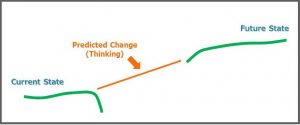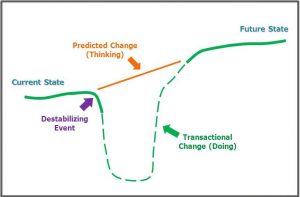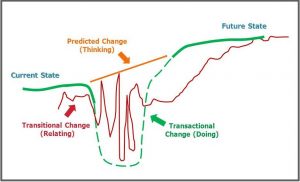An overview of our Change Model
 Change begins with a Current State – how things are right now – and looks forward to, and plans for, a Future State – how we want things to be on the other side of the change. We create a plan – how we think we will get to that Future State – shown here as the “orange line”. (Copyright on these images is held by Knowesys 2010.) We assume, predict (or hope) that we will be able to follow this plan and go directly from Current State to our desired Future State. But it almost never happens that way.
Change begins with a Current State – how things are right now – and looks forward to, and plans for, a Future State – how we want things to be on the other side of the change. We create a plan – how we think we will get to that Future State – shown here as the “orange line”. (Copyright on these images is held by Knowesys 2010.) We assume, predict (or hope) that we will be able to follow this plan and go directly from Current State to our desired Future State. But it almost never happens that way.
 Instead of following the Predicted Path, at some point something will happen that will force a deviation from that predicted plan. We call these Destabilizing Events, and they cause the organization to “fall” into what we call the Cauldron of Change (or, as one of our clients calls it, the “Conundrum of Chaos”). This “fall” creates a discrepancy between how the change is happening and how we thought it would happen (the Predicted Path). Now, new actions will need to be taken – this creates the “Green Line” or the Transactional Path of change.
Instead of following the Predicted Path, at some point something will happen that will force a deviation from that predicted plan. We call these Destabilizing Events, and they cause the organization to “fall” into what we call the Cauldron of Change (or, as one of our clients calls it, the “Conundrum of Chaos”). This “fall” creates a discrepancy between how the change is happening and how we thought it would happen (the Predicted Path). Now, new actions will need to be taken – this creates the “Green Line” or the Transactional Path of change.
 So far, so good – right?! But while we are navigating this unexpected and unfolding new path, another dynamic is at play. The Destabilizing Event also triggers people’s experience of and reaction to the change, the Transitional Change – or what we call the “Red Line.” This is the emotional reaction to change by the people involved – the dynamic that is too often ignored or avoided, but that must be addressed in order for the Green Line transactional path to succeed in guiding you out of the cauldron to the desired Future State. The challenge with the Red Line is that people’s experience of the change is usually unpredictable and often unknowable – yet this ongoing dynamic must be dealt with. How well (or how poorly) you deal with the Red Line determines how deeply your organization will fall into the cauldron and how long you will be there. The deeper and longer, the more painful it is for the organization – its people, its productivity, its finances, and its future.
So far, so good – right?! But while we are navigating this unexpected and unfolding new path, another dynamic is at play. The Destabilizing Event also triggers people’s experience of and reaction to the change, the Transitional Change – or what we call the “Red Line.” This is the emotional reaction to change by the people involved – the dynamic that is too often ignored or avoided, but that must be addressed in order for the Green Line transactional path to succeed in guiding you out of the cauldron to the desired Future State. The challenge with the Red Line is that people’s experience of the change is usually unpredictable and often unknowable – yet this ongoing dynamic must be dealt with. How well (or how poorly) you deal with the Red Line determines how deeply your organization will fall into the cauldron and how long you will be there. The deeper and longer, the more painful it is for the organization – its people, its productivity, its finances, and its future.
By understanding our change model in greater detail, and using our process and tools to navigate the Green Line and deal with the Red Line, you will reap two immediate benefits in the change initiative you have planned. You will spend less time in the cauldron, and it will be less painful while you are there. You’ll also reap long-term benefits. Your organization will be much better prepared for the next change (and it will come!) even if it’s brought on by some completely unexpected external destabilizing event.
